Seymour Geisser
Modes of Parametric Statistical Inference
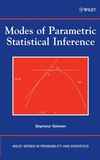 ISBN: 0-471-66726-9
ISBN: 0-471-66726-9
Hardcover
192 pages
January 2006
A fascinating investigation into the foundations of statistical
inference
This publication examines the distinct philosophical foundations
of different statistical modes of parametric inference. Unlike
many other texts that focus on methodology and applications, this
book focuses on a rather unique combination of theoretical and
foundational aspects that underlie the field of statistical
inference. Readers gain a deeper understanding of the evolution
and underlying logic of each mode as well as each mode's
strengths and weaknesses.
The book begins with fascinating highlights from the history of
statistical inference. Readers are given historical examples of
statistical reasoning used to address practical problems that
arose throughout the centuries. Next, the book goes on to
scrutinize four major modes of statistical inference:
The author provides readers with specific examples and
counterexamples of situations and datasets where the modes yield
both similar and dissimilar results, including a violation of the
likelihood principle in which Bayesian and likelihood methods
differ from frequentist methods. Each example is followed by a
detailed discussion of why the results may have varied from one
mode to another, helping the reader to gain a greater
understanding of each mode and how it works. Moreover, the author
provides considerable mathematical detail on certain points to
highlight key aspects of theoretical development.
The author's writing style and use of examples make the text
clear and engaging. This book is fundamental reading for graduate-level
students in statistics as well as anyone with an interest in the
foundations of statistics and the principles underlying
statistical inference, including students in mathematics and the
philosophy of science. Readers with a background in theoretical
statistics will find the text both accessible and absorbing.
Table of contents
Foreword.
Preface.
1. A Forerunner.
2. Frequentist Analysis.
3. Likelihood.
4. Testing Hypotheses.
5. Unbiased and Invariant Tests.
6. Elements of Bayesianism.
7. Theories of Estimation.
8. Set and Interval Estimation.
References.
Index.
Consul, Prem C., Famoye, Felix
Lagrangian Probability Distributions
 2006, XX, 352 p., Hardcover
2006, XX, 352 p., Hardcover
ISBN: 0-8176-4365-6
About this textbook
Lagrangian expansions can be used to obtain numerous useful
probability models, which have been applied to real life
situations including, but not limited to: branching processes,
queuing processes, stochastic processes, environmental
toxicology, diffusion of information, ecology, strikes in
industries, sales of new products, and production targets for
optimum profits. This book presents a comprehensive, systematic
treatment of the class of Lagrangian probability distributions,
along with some of its families, their properties, and important
applications.
Key features:
* Fills a gap in book literature
* Examines many new Lagrangian probability distributions, their
numerous families, general and specific properties, and
applications to a variety of different fields
* Presents background mathematical and statistical formulas for
easy reference
* Detailed bibliography and index
* Exercises in many chapters
Graduate students and researchers with a good knowledge of
standard statistical techniques and an interest in Lagrangian
probability distributions will find this work valuable. It may be
used as a reference text or in courses and seminars on
Distribution Theory and Lagrangian Distributions. Applied
scientists and researchers in environmental statistics,
reliability, sales management, epidemiology, operations research,
optimization in manufacturing and marketing, and infectious
disease control will benefit immensely from the various
applications in the book.
Written for:
Graduate students and researchers interest in discrete
probability distributions; applied scientists and researchers in
environmental statistics, reliability, sales management,
epidemiology, operations research, optimization in manufacturing
and marketing, and infectious disease control
Table of contents
Andrzej Ruszczynski
Nonlinear Optimization
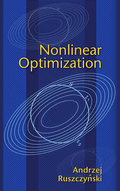 Cloth | 2006 | ISBN: 0-691-11915-5
Cloth | 2006 | ISBN: 0-691-11915-5
464 pp. | 6 x 9 | 35 line illus.
Optimization is one of the most important areas of modern applied
mathematics, with applications in fields from engineering and
economics to finance, statistics, management science, and
medicine. While many books have addressed its various aspects,
Nonlinear Optimization is the first comprehensive treatment that
will allow graduate students and researchers to understand its
modern ideas, principles, and methods within a reasonable time,
but without sacrificing mathematical precision. Andrzej
Ruszczynski, a leading expert in the optimization of nonlinear
stochastic systems, integrates the theory and the methods of
nonlinear optimization in a unified, clear, and mathematically
rigorous fashion, with detailed and easy-to-follow proofs
illustrated by numerous examples and figures.
The book covers convex analysis, the theory of optimality
conditions, duality theory, and numerical methods for solving
unconstrained and constrained optimization problems. It addresses
not only classical material but also modern topics such as
optimality conditions and numerical methods for problems
involving nondifferentiable functions, semidefinite programming,
metric regularity and stability theory of set-constrained
systems, and sensitivity analysis of optimization problems.
Based on a decade's worth of notes the author compiled in
successfully teaching the subject, this book will help readers to
understand the mathematical foundations of the modern theory and
methods of nonlinear optimization and to analyze new problems,
develop optimality theory for them, and choose or construct
numerical solution methods. It is a must for anyone seriously
interested in optimization.
Andrzej Ruszczynski is Professor of Operations Research at
Rutgers University. He is the coauthor of Stochastic Programming
and the coeditor of Decision Making under Uncertainty.
Endorsements:
"Nonlinear Optimization will become the standard textbook on
its subject, as well as a reference book that everyone will want
to own. Not only is it beautiful and elegant, it is also utterly
comprehensive and modern, with many realistic and interesting
examples."--Robert J. Vanderbei, Princeton University,
author of Linear Programming
"This excellent book is the best I have reviewed in the past
ten years. Very well written, its three main strengths are its
treatment of theory and algorithms on equal terms, its
mathematically driven presentation of the material, and its
interesting examples and applications."--Ekkehard W. Sachs,
Virginia Tech and Universitat Trier
Table of contents
Ehrig, H., Ehrig, K., Prange, U., Taentzer, G.
Fundamentals of Algebraic Graph Transformation
 Series: Monographs in Theoretical Computer Science. An EATCS Series
Series: Monographs in Theoretical Computer Science. An EATCS Series
2006, XIV, 388 p. 41 illus., Hardcover
ISBN: 3-540-31187-4
About this book
Graphs are widely used to represent structural information in the
form of objects and connections between them. Graph
transformation is the rule-based manipulation of graphs, an
increasingly important concept in computer science and related
fields. This is the first textbook treatment of the algebraic
approach to graph transformation, based on algebraic structures
and category theory.
Part I is an introduction to the classical case of graph and
typed graph transformation. In Part II basic and advanced results
are first shown for an abstract form of replacement systems, so-called
adhesive high-level replacement systems based on category theory,
and are then instantiated to several forms of graph and Petri net
transformation systems. Part III develops typed attributed graph
transformation, a technique of key relevance in the modeling of
visual languages and in model transformation. Part IV contains a
practical case study on model transformation and a presentation
of the AGG (attributed graph grammar) tool environment. Finally
the appendix covers the basics of category theory, signatures and
algebras.
The book addresses both research scientists and graduate students
in computer science, mathematics and engineering.
Written for:
Researchers, lecturers, graduate students
Table of contents
Part I: Introduction to Graph Transformation Systems: General
Introduction.- Graphs, Typed Graphs, and the Gluing Construction.-
Graph Transformation Systems.- Part II: Adhesive High-Level
Replacement Categories and Systems: Adhesive High-Level
Replacement Categories.- Adhesive High-Level Replacement Systems.-
Embedding and Local Confluence.- Constraints and Application
Conditions.- Part III: Typed Attributed Graph Transformation
Systems: Typed Attributed Graphs.- Typed Attributed Graph
Transformation Systems.- Embedding and Local Confluence for Typed
AGT Systems.- Adhesive HLR Categories for Typed Attributed Graphs.-
Constraints, Application Conditions and Termination for TAGT
Systems.- Typed Attributed Graph Transformation with Inheritance.-
Part IV: Case Study on Model Transformation, and Tool Support by
AGG: Case Study on Model Transformation.- Implementation of Typed
Attributed Graph Transformation by AGG.- Appendices: A Short
Introduction to Category Theory.- A Short Introduction to
Signatures and Algebras.- Detailed Proofs.- References.- Index.
V. I. Krylov
Arthur H. Stroud
Approximate Calculation of Integrals
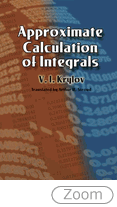 ISBN: 0486445798
ISBN: 0486445798
Page Count: 368
Dimensions: 5 3/8 x 8 1/2
A systematic introduction to the principal ideas and results of
the contemporary theory of approximate integration, this volume
approaches its subject from the viewpoint of functional analysis.
In addition, it offers a useful reference for practical
computations. The three-part treatment begins with concepts and
theorems encountered in the theory of quadrature. The second part
is devoted to the problem of calculation of definite integrals,
and the final part of the book explores methods for the
calculation of indefinite integrals. 1962 ed.
Table of Contents
Translator's Preface
Part I. Preliminary Information
Chapter 1. Bernoulli Numbers and Bernoulli Polynomials
2. Orthogonal Polynomials
3. Interpolation of Functions
4. Linear Normed Spaces. Linear Operators
Part II. Approximate Calculation of Definite Integrals
5. Quadrature Sums and Problems Related to Them. The Remainder in
Approximate Quadrature
6. Interpolatory Quadratures
7. Quadratures of the Highest Algebraic Degree of Precision
8. Quadrature Formulas with Least Estimate of the Remainder
9. Quadrature Formulas Containing Preassigned Nodes
10. Quadrature Formulas with Equal Coefficients
11. Increasing the Precision of Quadrature Formulas
12. Convergence of the Quadrature Process
Part III. Approximate Calculation of Indefinite Integrals
13. Introduction
14. Integration of Functions Given in Tabular Form
15. Calculation of Indefinte Integrals Using a Small Number of
Values of the Integrand
16. Methods Which Use Several Previous Values of the Integral
Appendix A. Gaussian Quadrature Formulas for Constant Weight
Function
Appendix B. Gaussian-Hermite Quadrature Formulas
Appendix C. Gaussian-Laguerre Quadrature Formulas
Index
Louis Brand
Advanced Calculus: An Introduction to Classical Analysis
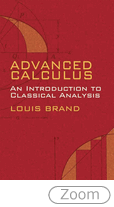 ISBN: 0486445488
ISBN: 0486445488
Page Count: 592
Dimensions: 5 3/8 x 8 1/2
A course in analysis that focuses on the functions of a real
variable, this text is geared toward upper-level undergraduate
students. It introduces the basic concepts in their simplest
setting and illustrates its teachings with numerous examples,
practical theorems, and coherent proofs. Starting with the
structure of the system of real and complex numbers, it covers
the convergence of sequences and series and explores the
functions of a real variable and of several variables. Subsequent
chapters offer a brief, self-contained introduction to vectors
and the important differential invariants, the reversal of order
in limiting processes, and Fourier series. 1955 ed.
Table of Contents
1. The Number System
2. Sequences and Series
3. Functions of a Real Variable
4. Functions of Several Variables
5. Vectors
6. The Definite Integral
7. Improper Integrals
8. Line Integrals
9. Multiple Integrals
10. Uniform Convergence
11. Functions of a Complex Variable
12. Fourier Series
Appendixes
Comprehensive Test
Answers to Problems
Index
Hassler Whitney
Geometric Integration Theory
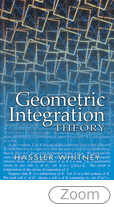 ISBN: 0486445836
ISBN: 0486445836
Page Count: 400
Dimensions: 5 3/8 x 8 1/2
Geared toward upper-level undergraduates and graduate students, this treatment of geometric integration theory consists of three parts: an introduction to classical theory, a postulational approach to general theory, and a final section on Lebesgue theory. The opening third of the treatment leads to the theory of the Riemann integral and includes a study of smooth manifolds. The second part explores abstract integration theory, some relations between chains and functions, general properties of chains and cochains, and chains and cochains in open sets. The final section surveys Lebesgue theory in terms of flat cochains and differential forms, Lipschitz mappings, and chains and additive set functions. Useful appendixes and indexes conclude the text. 1957 ed.
Table of Contents
Introduction
A. The general problem of integration
B. Some classical topics
C. Indications of general theory
Part I. Classical Theory
1. Grassmann algebra
2. Differential forms
3. Riemann integration theory
4. Smooth manifolds
A. Manifolds in Euclidean space
B. Triangulation of manifolds
C. Cohomology in manifolds
Part II. General Theory
5. Abstract integration theory
6. Some relations between chains and functions
7. General properties of chains and cochains
8. Chains and cochains in open sets
Part III. Lebesgue Theory
9. Flat cochains and differential forms
10. Lipschitz mappings
11. Chains and additive set functions
Appendix I. Vector and linear spaces
Appendix II. Geometric and topological preliminaries
Appendix III. Analytical preliminaries
Index of symbols
Index of terms
 ISBN: 0-471-66726-9
ISBN: 0-471-66726-9 2006, XX, 352 p., Hardcover
2006, XX, 352 p., Hardcover Cloth | 2006 | ISBN: 0-691-11915-5
Cloth | 2006 | ISBN: 0-691-11915-5 Series: Monographs in Theoretical Computer Science. An EATCS Series
Series: Monographs in Theoretical Computer Science. An EATCS Series  ISBN: 0486445798
ISBN: 0486445798  ISBN: 0486445488
ISBN: 0486445488  ISBN: 0486445836
ISBN: 0486445836